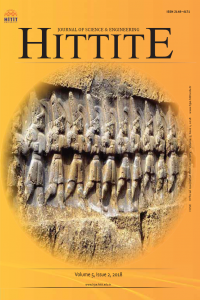Abstract
References
- Özgül, N. Bozkır-Hadim-Taşkent (Orta Toroslar'ın kuzey kesimi) dolayında yer alan tektono-stratigrafik birliklerin stratigrafisi. Maden Tetkik ve Arama Dergisi 119 (1997) 113-174.
- Özgül, N, Arpat, E. Structural units of Taurus orogenic belt and their continuation in the neighbouring regions. Geological Society of Greece Bulletin 10 (1973) 156-164.
- Gutnic, M, Monod, O, Poisson, A, Dumont, JF. Geeologie des Taurides occidentales (Turquie), Societe Geologique de France, Paris, 1979.
- Gedik, A, Birgili, Ş, Yılmaz, H, Yoldaş, R. Mut-Ermenek- Silifke Yöresinin Jeolojisi ve Petrol Olanakları. Türkiye Jeoloji Kurumu Bülteni 22 (1979) 7-26.
- Bassant, P, Van Buchem, FSP, Strasser, A, Görür, N. The stratigraphic architecture and evolution of the Burdigalian carbonate-siliciclastic sedimentary systems of the Mut Basin, Turkey. Sedimentary Geology 173 (2005) 187-232.
- Reed, SJB. Electron microprobe analysis and scanning electron microscopy in geology, Cambridge University Press, U.K., 2005.
- Goldstein, JI, Newbury, DE, Echlin, P, Joy, DC, Fiori, C, Lifshin, E. Scanning electron microscopy and X-Ray microanalysis, Plenum Publishing, New York, 1981.
- Tite, MS, Freestone, IC. The use of scanning electron microscopy in the technological examination of ancient ceramics, in: J.S. Olin, A.D. Franklin (Eds.) Archaeological Ceramics, Smithsonian Institution Press, Washington, pp. 109-120, 1982.
- Freestone, IC, Middletonand, AP. Mineralogical applications of the analytical SEM in archaeology. Mineralogical Magazine 51 (1987) 21-31.
- Froh, J. Archaeological ceramics studied by scanning slectron microscopy. Hyperfine Interactions 154 (2004) 159-176.
- Laviano, R, Muntoni, IM. Provenance and technology of Apulian Neolithic pottery, in: M. Maggetti, B. Messiga (Eds.) Geomaterials in Cultural Heritage Geological Society Special Publications, London, pp. 49-62, 2006.
- Wassilkowska, A, Czaplicka-Kotas, A, Zielina, M, Bielski, A. An analysis of the elemental composition of micro-samples using EDS technique. Technical Transactions 1 (2014) 133- 148.
- Morton, AC. Stability of detrital heavy tertiary sandstones from the north sea basin. Clay minerals 19 (1984) 287-308.
- Pettijohn, FJ, Potter, PE, Siever, R. Sand and Sandstone, Springer New York, 1987.
- Force, ER. Geology of titanium-mineral deposits, Geological Society of America, U.S.A, 1991.
- Cox, R, Lowe, DR, Cullers, RL. The influence of sediment recycling and basement composition on evolution of mudrock chemistry in the southwestern United States. Geochimica et Cosmochimica Acta 59 (1995) 2919-2940.
Mineralogical and Geochemical Characterization of Ancient Ceramic Sherds from Dipsizin Cave Karaman, Turkey
Abstract
Raw materials of two ancient ceramic sherds ceramic-1 and ceramic-2 from Dipsizin cave were analyzed by SEM-EDS in order to characterize ceramic fabrics. Characterization includes separation of temper and clay paste sections, qualitative determination of mineralogical compositions and percentage calculations of raw materials by region sketching. In this perspective, ceramic-1 is characterized as % 41.83 temper quartz, albite, rutile, lime, organic material and % 58.17 clay paste. Then, ceramic-2 is characterized to be % 37.52 temper quartz, anorthoclase, rutile, lime, organic material and % 62.48 clay paste. Clay paste sections of both ceramics include mixture of clay minerals belonging to illite and smectite clay groups. In comparison, percentages of temper and clay paste sections of ceramic-1 and ceramic-2 differ % 4.31 from each other and variety of raw materials making up both ceramic bodies are nearly same except feldspars. But individually quartz and lime percentages between ceramics differ nearly two times. In this opinion we realize that raw materials are mixed by tracking two recipes. These recipes can be explained by different pottery making technologies and/or different archaeological provenances.
References
- Özgül, N. Bozkır-Hadim-Taşkent (Orta Toroslar'ın kuzey kesimi) dolayında yer alan tektono-stratigrafik birliklerin stratigrafisi. Maden Tetkik ve Arama Dergisi 119 (1997) 113-174.
- Özgül, N, Arpat, E. Structural units of Taurus orogenic belt and their continuation in the neighbouring regions. Geological Society of Greece Bulletin 10 (1973) 156-164.
- Gutnic, M, Monod, O, Poisson, A, Dumont, JF. Geeologie des Taurides occidentales (Turquie), Societe Geologique de France, Paris, 1979.
- Gedik, A, Birgili, Ş, Yılmaz, H, Yoldaş, R. Mut-Ermenek- Silifke Yöresinin Jeolojisi ve Petrol Olanakları. Türkiye Jeoloji Kurumu Bülteni 22 (1979) 7-26.
- Bassant, P, Van Buchem, FSP, Strasser, A, Görür, N. The stratigraphic architecture and evolution of the Burdigalian carbonate-siliciclastic sedimentary systems of the Mut Basin, Turkey. Sedimentary Geology 173 (2005) 187-232.
- Reed, SJB. Electron microprobe analysis and scanning electron microscopy in geology, Cambridge University Press, U.K., 2005.
- Goldstein, JI, Newbury, DE, Echlin, P, Joy, DC, Fiori, C, Lifshin, E. Scanning electron microscopy and X-Ray microanalysis, Plenum Publishing, New York, 1981.
- Tite, MS, Freestone, IC. The use of scanning electron microscopy in the technological examination of ancient ceramics, in: J.S. Olin, A.D. Franklin (Eds.) Archaeological Ceramics, Smithsonian Institution Press, Washington, pp. 109-120, 1982.
- Freestone, IC, Middletonand, AP. Mineralogical applications of the analytical SEM in archaeology. Mineralogical Magazine 51 (1987) 21-31.
- Froh, J. Archaeological ceramics studied by scanning slectron microscopy. Hyperfine Interactions 154 (2004) 159-176.
- Laviano, R, Muntoni, IM. Provenance and technology of Apulian Neolithic pottery, in: M. Maggetti, B. Messiga (Eds.) Geomaterials in Cultural Heritage Geological Society Special Publications, London, pp. 49-62, 2006.
- Wassilkowska, A, Czaplicka-Kotas, A, Zielina, M, Bielski, A. An analysis of the elemental composition of micro-samples using EDS technique. Technical Transactions 1 (2014) 133- 148.
- Morton, AC. Stability of detrital heavy tertiary sandstones from the north sea basin. Clay minerals 19 (1984) 287-308.
- Pettijohn, FJ, Potter, PE, Siever, R. Sand and Sandstone, Springer New York, 1987.
- Force, ER. Geology of titanium-mineral deposits, Geological Society of America, U.S.A, 1991.
- Cox, R, Lowe, DR, Cullers, RL. The influence of sediment recycling and basement composition on evolution of mudrock chemistry in the southwestern United States. Geochimica et Cosmochimica Acta 59 (1995) 2919-2940.
Details
| Primary Language | English |
|---|---|
| Journal Section | Research Article |
| Authors | |
| Publication Date | June 29, 2018 |
| Published in Issue | Year 2018 Volume: 5 Issue: 2 |
Hittite Journal of Science and Engineering is licensed under a Creative Commons Attribution-NonCommercial 4.0 International License (CC BY NC).


